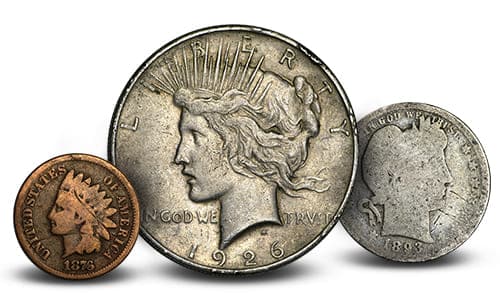
Any coin, regardless of its material or design, may be designated as cull if it is in poor condition. Any number of flaws, from cosmetic problems to structural defects, can justify this classification. Holes, scratches, pitting and bends are common among cull coins, as well as severe retooling, dark toning and even poorly performed repairs. By professional coin appraisal and grading standards, which consider a coin’s strike, preservation, luster, color and attractiveness, cull coins range from Fair to Basal State, or Poor.
CIRCULATED VS UNCIRCULATED CULL COINS
When a numismatic expert is grading the quality of a coin, the discretion for cull coins differs heavily between uncirculated and circulated coins. Take for example Morgan Dollar coins versus Silver American Eagle coins – Since the Morgan Dollar was put into circulation, meaning U.S. citizens used it as currency, there will be more wear and scratches on those coins. Silver Eagles have never been circulated so they will have much less wear and fewer visible scratches. For these reasons, a cull Morgan Dollar is going to be visibly very different than a cull Silver American Eagle.
CULL COINS RETAIN VALUE AS PRECIOUS METALS
A collector may choose to purchase a cull coin for its unique design or historical significance. For example, cull coin Morgan Silver dollars were the first coins to feature Lady Liberty in an American rather than Greek style. These vintage coins are a favorite among numismatists and can be purchased in cull condition at a lower premium than their undamaged or uncirculated counterparts.
COLLECTING CULL COINS
Part of the appeal of coin collecting is that coins will always retain their inherent value as Precious Metals. For example, no matter how damaged a Gold coin may be, you can be sure it is at least worth the spot price value for its weight in Gold.
AVOID THESE MISTAKES
There are several industry and personal practices you should be aware of that automatically make coins a cull quality. The two most common practices are cleaning and coin coloring. The first happens when someone wants to “shine up” their old coin. This is a big no-no and as soon as you do it, you have turned your coin into cull quality. Cleaning a coin is very tempting because everyone wants to make their coin look great. However, coins get their grades and value in the numismatic market by their originality. Altering this originality heavily decreases the numismatic value of your coin.
COIN COLORING
The other common practice is coin coloring. While it may be visually appealing to add colors by painting the coin, the painter has now devalued the coin to a cull condition. Again, this type of practice alters the originality of a coin. The big takeaway here is this: When you purchase a Gold or Silver coin, do your best to not alter the coin’s original state. The easiest way to protect your coins is by storing them properly, which will help hold your coin’s value over the long run.
Shop our assortment of currency and rare coins to expand your collection today.





